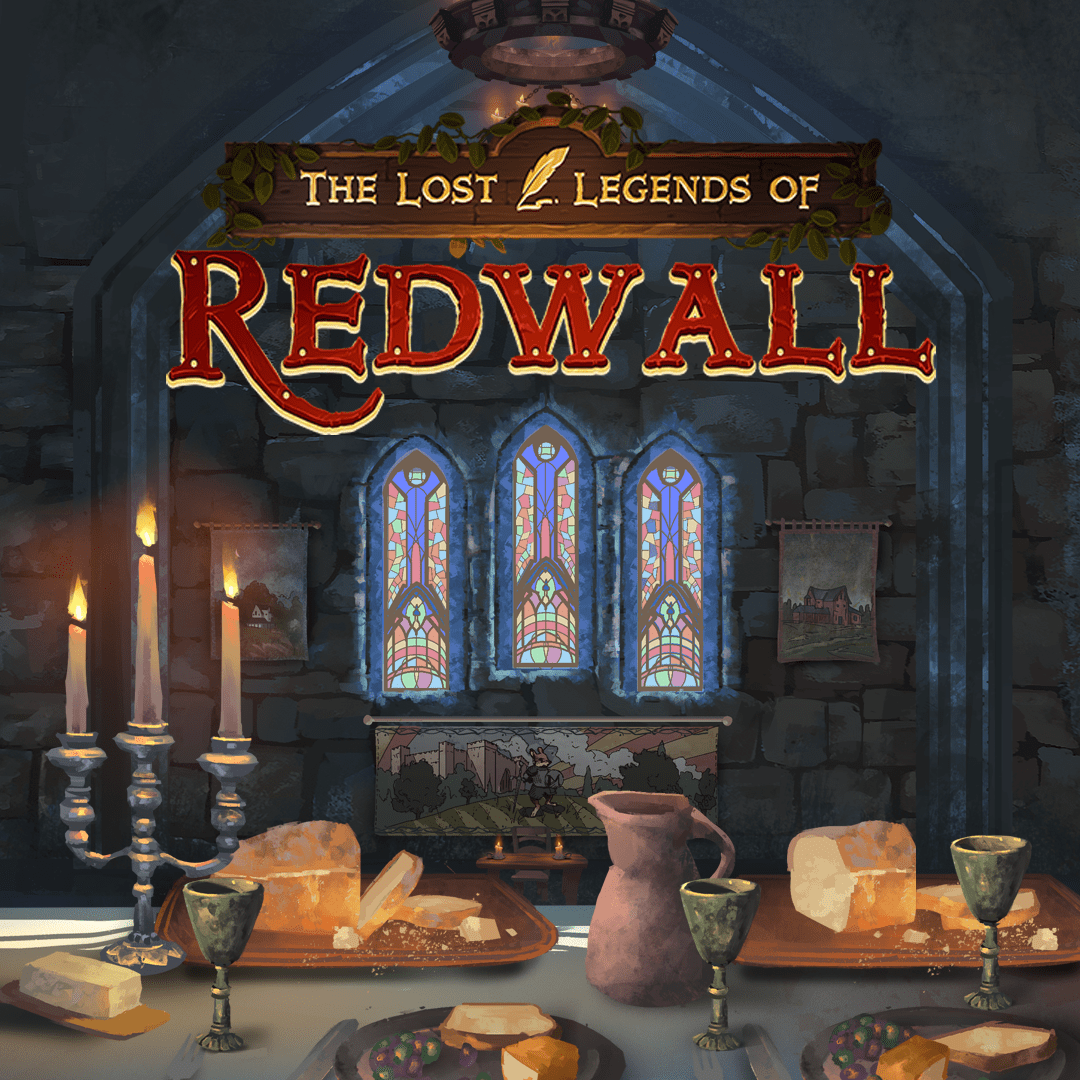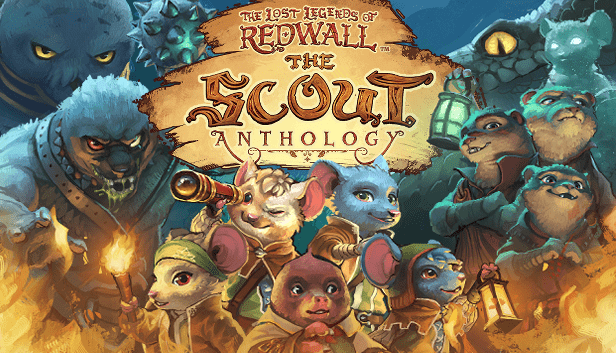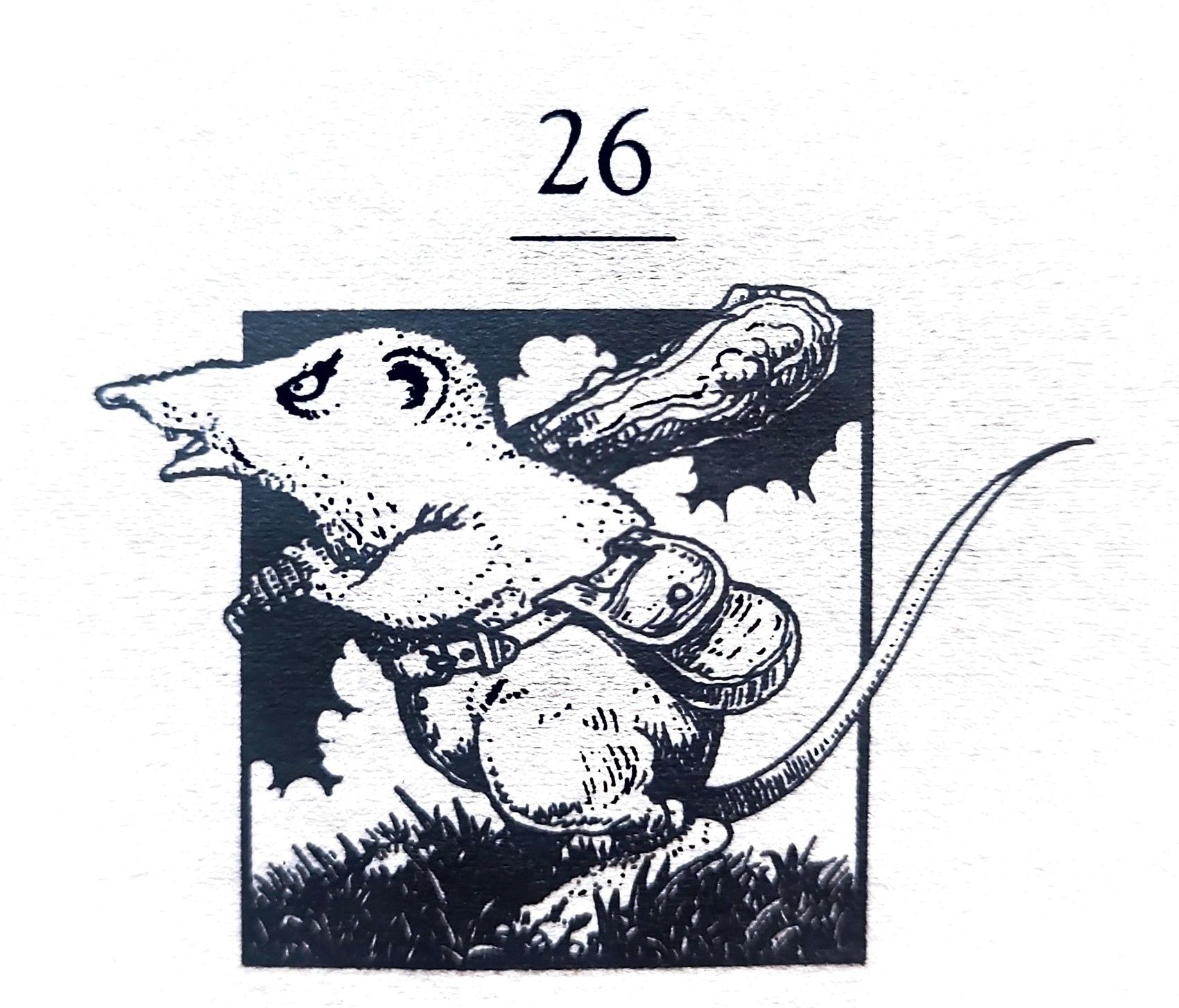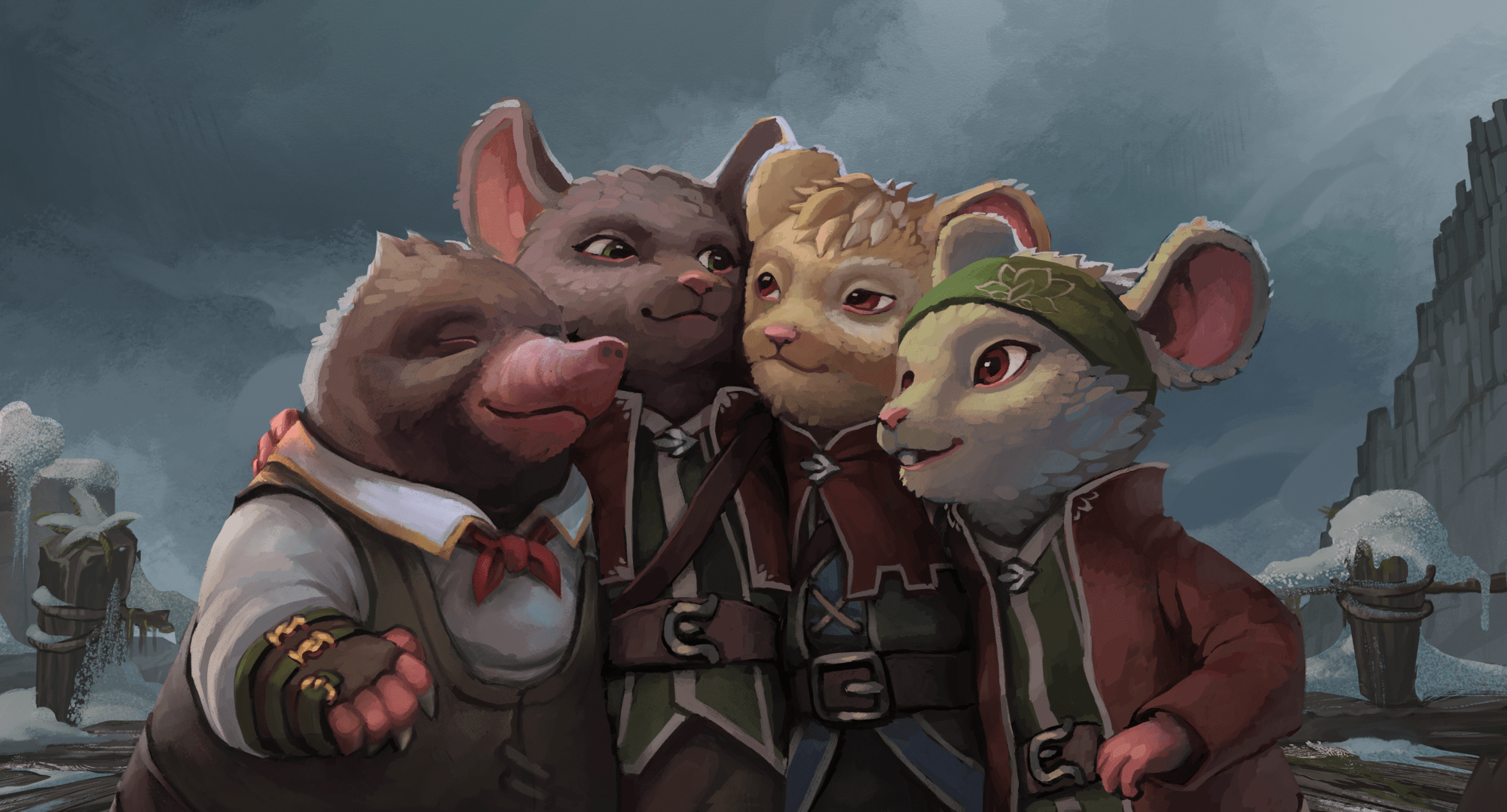——-
Here at Soma Games, we are so excited to share with you this post, written by the two writers who led the charge in the creation of the scripts for The Scout: Act 2 & 3, as well as the stories within our new Redwall interactive fiction App! Heather Rose Walters served as the Narrative Lead for these projects, and Ren-Alex Rose as a Narrative Designer and Game Writer.
——-
The first Redwall, written by the inimitable Brian Jacques, was published in 1986. Between that time and the author’s passing in 2011, there were 21 total novels published — and one more published posthumously. The books span decades, and the stories themselves span what we humans might think of as centuries. Characters of one novel might be only known as legends in another. This only adds to the timeless feel of the stories, the unique way they can delight us at so many ages. Readers who love Redwall usually are introduced to them as children; we discovered them on the shelf of our sixth-grade classrooms, or on a trip to the library with our little sibling. After the initial discovery, most Redwall readers fall hard and fast into the Redwall universe, devouring whatever novels were available to us and then eagerly awaiting the next release, growing up with the anthropomorphic animal adventurers and learning, as we grew, about right and wrong, bravery and honor, truth and friendship, and of course how and when to properly feast (the answer being enthusiastically, and often!).
The love readers have for this series is comparable to the likes of Harry Potter or The Lord of the Rings; it’s not just a preference, it’s a personality. It’s part of who we are, because we grew up weaving it into ourselves as hungry children, uncertain teenagers, and maturing adults. So, as writers, how do we face the task of actually adapting an IP so wildly beloved?
That is truly a nerve-wracking undertaking.
But that is exactly what we two writers were asked to do. First, we joined Parts 2 & 3 of the 3D puzzle-adventure game The Lost Legends of Redwall: The Scout. Then, we built a brand new interactive fiction app called The Lost Legends of Redwall (iOS and Android), complete with several new interactive fiction (IF) tales set in the same timeline that we both adapted (The Caverns of Kotir, The Flower of Icetor) and originated (The Wildcat Scroll). To do this justice, there were several major elements we had to consider: how to make the linear novels successfully interactive, how to operate within the established (and often inconsistent) limitations of the Redwall world, how to imitate and write in homage to the unique and beloved Jacques writing style, the unique character style of the original stories, and the iconic fictional home to so many creatures and readers alike: the Abbey itself.
Designing a Branching Narrative
As novels, the Redwall series were linear, page-by-page stories, as novels tend to be. But in adapting the Redwall world into interactive fiction, we needed to find the best way to tell branching tales while retaining the same magic that initially pulled fans into the series. And so we asked ourselves: who do Redwall fans want to be? Where do they want to go? What do they want to do? And most importantly, what is the story that is needed most by our audience?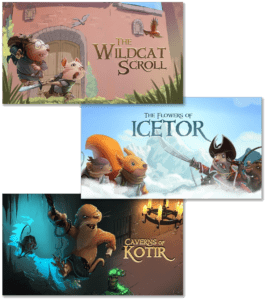
The answer we found to be true for both ourselves and for many other fans was simple: We want to be like Martin the Warrior. We want to be a young, spry hero like Matthias, and we want to be brave like Mariel. We want to rise from humble, insecure places to become heroes of Mossflower Woods in our own ways, whether as warriors, healers, or scholars, just as the characters in the books do.
We created the protagonists of The Wildcat Scroll to reflect just this — hopeful, dreaming youngsters who stare at tapestries of Martin and Matthias, which they’ve hung on the walls of their Redwall dormitory, yearning to follow in the heroes’ pawsteps. And the story we’ve written for them is about doing just that. In The Wildcat Scroll, players choose to study as either a Warrior, a Healer, or a Scholar, as the woodlanders of the Abbey do. They hone their skills, build their personality, and choose their loyalties, ultimately creating their own Redwall story within the world events we, as narrative designers, pre-determine. All while in the paws of a mouse.
This structure is not particularly unique from other examples of branching narrative, or RPGs, action-adventure games, or any other narrative-driven game. But it’s never been done in Redwall before, despite it being called for by fans for years. With every choice we created along the path players may take through the IF tales, we heavily considered what lifelong fans of the series have wanted, from the overarching plot to the tiny details. We asked fans what they love about Redwall and what they don’t. What would they change about the series? This is the knowledge we used to build a Redwall world that is both the same as that created by Jacques nearly forty years ago and different — it’s a process that considered how modernity has influenced the fans and what they wanted to see Redwall grow into.
Creating Original Characters in Old Worlds
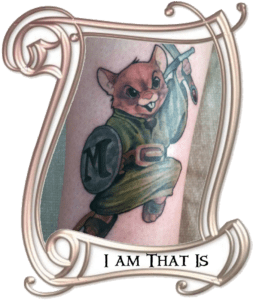
The most famous heroes of the Redwall universe, Martin and Matthias the Warriors, have been adopted by fans as characters as beloved as the series itself. Many fans talk of how they looked up to the characters as noble role models from childhood all the way into adulthood, some even tattooing the images of the characters, scenes, or swords on themselves.
While we as writers did not want to tread upon the mark Jacques’ famous warriors left upon both fans and Mossflower Woods itself, we wanted to create something new, for both a young audience fresh into Redwall and for fans from the older generation.
And so we built modern champions who mimic the heroes of old, much like what we wanted players to do in The Wildcat Scroll, as discussed above. And yet, the path the heroes take is often not what they expect, much like life so often works. Many of the protagonists don’t even realize they are heroes, and some others end up not much like heroes at all. We wanted players to connect with our new, original protagonists, but still see in them the characters that were beloved in the first place.
But there was something else we wanted to explore. In Jacques’ Redwall novels, often characters are separated into two groups: vermin and woodlander. Vermin characters are “bad” critters, the villains of the story, while woodlanders are “good” critters. But vermin were almost always tied to specific species such as rats, weasels, cats, or other “tough” critters, while woodlanders were mice, squirrels, moles, and other “gentle” critters.
There are instances in the novels where this consistent trope is challenged, but we decided to take it a step further. We wanted to press the theme that everyone can choose good, and equally, everyone can choose bad. No one is more capable of evil than anyone else simply based on their species. Stoats can be heroes chosen by Martin as easily as Abbey mice could prove selfish or deceitful. Even if “Good” and “Evil” are real and objective, real life is incredibly complicated and our actions are always somewhere in the gray. This, we felt, was more true to life and a better story to tell.
Stoats in specific play a significant role in The Lost Legends of Redwall. In The Scout, we introduce the Scrimpaw family, a trio of stoats living in a shipwreck refurbished into a cozy home. They are good stoats, the father once loyal to vermin hordes now dedicated to leading a good, “woodlander” life. But this is a struggle for him and his children, who are often misjudged or unwelcome in traditionally “woodlander” spaces, such as Redwall Abbey, who fear the stoats may not be the kind critters they claim to be or may revert to their old ways. Our own mouse protagonists of The Scout too fear the Scrimpaws at first, before learning the flaw of their prejudice. The Scrimpaws also appear in The Flowers of Icetor IF game, allowing players of the IF to form their own ideas about these characters. The plot of The Wildcat Scroll is also very attentive to this question of good and evil, this time in the form of wildcats descended from one of Jacques’ most famous villains and Martin’s adversary, Queen Tsarmina.
Fans themselves have been probing this question for decades, and we found that fans love traditionally “vermin” characters such as cats, ferrets, and foxes and want them in shoes other than those worn by villains. And so our stories give this to them, presenting wildcat heroes, sympathetic rats, and troublesome mice. This challenge of the social standard presented in Jacques’ original work is invaluable to modern Redwall writing, and yet we hope still remains true to the world he built.
Building Atop a Beloved Foundation
The Redwall world of Mossflower Woods and Beyond has existed since 1986 when Jacques’ first novel was published. The world is expansive, as well as sometimes contradictory. For example, the first novel implied the existence of humans in this Redwall world. Rats ride upon a cart pulled by a horse, a cat lives inside a hay barn, and some of the buildings are implied to be so large, it takes hours for the little characters to climb up the many floors…as though they had been built for humans, not mice.
Yet in all the novels following, everything suddenly appears to be properly Mouse-sized. There is no mention of “horses” or stairwells meant for human feet. Jacques himself admitted that when he wrote the first Redwall novel, he wasn’t sure where he intended to go with the world-building, or if he intended to continue with the series at all.
This is just one example of many contradictions scattered across the series, which made designing Soma’s Redwall world a bit more complicated. When faced with contradictions, which description of St. Ninian’s Church do we build from? Is it a church, as described in the first novel, or is it simply a humble home, as shown later?
It took much research, discussion, and audience feedback to come to these conclusions. We never wanted to go against what fans of Redwall wanted (unless we had very good reason to), and we didn’t want to disrespect Jacques’ creation by overwriting his work.
Similarly, there came a question of size. How big is the world? Who is “average” sized? And is the world built with them in mind or someone larger or smaller?
The answer we came up with was to create a visual world that was built around Redwall creatures as that “average” species, instead of humans. We imagine that squirrels and otters are the standard ‘human’ size, and mice and the like are more like children in stature. Trees were sized with this in mind, and when introducing Lilygrove Village, for example, this made sense. Spatial perspective was no different than when we, as humans, expect when we step outside and see our own world. But this becomes interesting when our mice protagonists travel to other locations. For example, stoats are significantly taller than mice, some three to four times as large. The home of a stoat is therefore built with stoat sizing in mind. Suddenly, as a mouse, we are small. Similarly, when in boats built by tiny shrews, we are large. Conversely, because Redwall Abbey is home to many species of varying size, from dibbun moles to massive badger mums, the Abbey hosts a combination of all sized objects. The feasting tables we built have different-sized chairs for all creatures, all placed next to one another so no one is ever left out.
While some of this sizing difference is implied in the Redwall novels, building it in a video game space became great fun and allowed for the game’s intriguing narrative, level, and puzzle design. In this sense, a visual world took Redwall to heights it didn’t reach in the novels, because of the inherent difference in the mediums.
Redwall is Home
The Redwall world spans oceans and volcanoes, forests and caves, deserts and riverbeds, and yes, one very special Abbey. No matter how far the stories took us in any given book, that Abbey was always the home waiting for us — even if it was only a glimmer in Martin’s eye at the time.
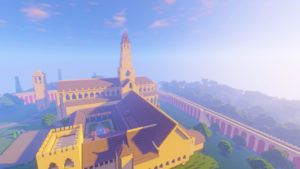
That was a particular challenge for our writing process. As far as the fans were concerned, a Redwall game would feel like a loss if it didn’t mention the Abbey at all; then it’s just a game of talking animals. But neither could we also set every story in the Abbey itself; that would place an unnecessary limit on a vibrant world of opportunity, and even worse, possibly feel anticlimactic if a player was just suddenly gifted the Redwall space without any work or anticipation for it. That was the initial reasoning behind Soma’s building of Lilygrove and the Scout Corps — a decision that, to be fair, we weren’t part of, as we weren’t on the team for the creation of Soma’s first Redwall game, The Scout: Act 1. But we resonated with the reasoning, and our writing for The Scout: Acts 2 and 3 fed into it: instead of starting at Redwall, Redwall became the goal. The best healers are at Redwall. The player’s betrothed is injured. Even if our lead mouse doesn’t know it at first, the player can easily deduce: the path of this narrative certainly will lead to Redwall. It made for a perfect meta goal for the player. For the story’s sake, the player wants to save their village and their fiancé — but for their own sake, they are eager to see a visual recreation of a fictional place they’ve loved for years.When it came to the interactive fiction games, things shifted for us. We decided to set The Wildcat Scroll in Redwall itself, with a young hero who longs for approval and adventure — much like many of the novels actually begin. We got to explore the Abbey ourselves, in our writing and descriptions. The Redwall Abbey Minecraft previously built by Soma became quite useful here, as the artists had spent considerable time researching how exactly Redwall would be laid out. Equally useful was a timeline Ren Alex-Rose created, which noted the state of the Abbey through the ages of the Redwall world, among other things. What Ren and the Minecraft artists discovered, and what any Redwall reader will likely remember, is that Jacques isn’t always consistent in his descriptions. Rooms exist in one book that don’t exist in another, as do pathways and the occasional door. Sometimes this can be explained with the passage of time, but other times, it really is just a contradiction. Jacques wasn’t as fussed as the modern writer is about continuity; it was more important to him that the heart of everything be consistent, and that mentality served him well. It just left some of us with a few questions.
What this meant, of course, was that we were free to make a few assumptions of our own. We based our stories off the Minecraft world, and we added details where we saw fit. This made for a truly fun process: yes, we had a world that was well-known that we needed to stick to, but we also had more freedom than the average IP writer has. We added our own touches based on what we believed worked for Redwall, what made sense for the stories we were telling now, and what would resonate the strongest with a modern audience.
Brian Jacques’ Voice
“Even the strongest and bravest must sometimes weep. It shows they have a great heart, one that can feel compassion for others.”
That quote, from the original Redwall novel, is one of our favorites, although there are many to choose from. Jacques’ uniquely melodic, equal parts somber and whimsical voice brought readers to tears and made us laugh out loud. His own narrating voice was almost as iconic a character as Martin himself!
Our pursuit of Jacques’ style ended up striking a certain balance. As writers, we read and re-read the novels as many times as we could muster in the hopes of internalizing his unique voice. We wanted the games — and especially the interactive fiction — to feel like a Redwall book. But we also had to consider that this was a different medium. First of all, the player was acting as a character — not reading about the character. That already created a more immediate feel than the novels themselves had. We had to be cautious not to let that sweep us away, but at the same time, we didn’t want to diminish it too much. For the medium of games, more immediacy can help move the story and draw the player in, making it more immersive. That was important to us. Plus, we felt it important to acknowledge that we could not be Jacques, nor should we try to mimic him to perfection. We are, after all, our own writers, and whether we wanted it to or not, our own styles were going to creep in there. If we could be intentional and gentle about it, we could choose how that happened, rather than let it overrun the prose unnecessarily.
We hope that we achieved this tenuous balance, but we’ll leave that up to players to decide.
Conclusion
Our experience writing in the Redwall universe was an honor and a gift. With an IP treasured by so many, as writers our goal is always to do right by the author, the stories, and the fans. It was certainly a process and a challenge, but as readers and fans ourselves, it was well worth it. We hope that as players explore new adventures with new characters, they’ll feel the warmth of that old world they love so well.

